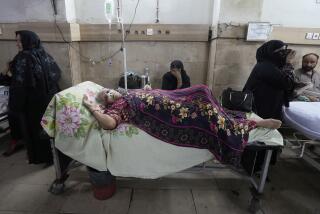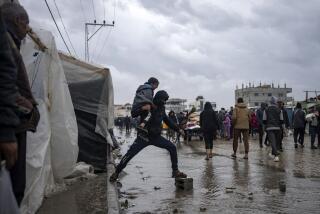Big Aftershocks Set Back Relief Efforts in Pakistan
- Share via
ISLAMABAD, Pakistan — Three powerful aftershocks of the Oct. 8 earthquake triggered fresh landslides and panic across northern Pakistan on Wednesday as relief workers warned that thousands more deaths from disease and exposure could occur among the 500,000 people still stranded in mountain villages.
The new setbacks in getting aid to cold and injured survivors dampened spirits in the hardest-hit areas, where a day earlier President Pervez Musharraf proposed opening the divided territory of Kashmir to allow family contact and better flow of aid.
Though even Pakistani militants seeking independence for the Indian-controlled portion of Kashmir hailed that idea, it became obvious Wednesday that crossings of the so-called Line of Control were weeks if not months away.
Damaged roads and bridges must be repaired before significant traffic can move across the boundary, said Tasnim Aslam, a spokeswoman for the Pakistani Foreign Ministry.
Asked how long it would take to allow family visits and aid deliveries, she said Pakistani authorities wanted them to occur “not in months but rather more quickly.”
The first telephone calls in 15 years from the Indian-held portion of Kashmir to relatives on the Pakistani side took place after four emergency call centers were opened Wednesday by Indian authorities.
Aslam said Pakistan was pushing to extend its cellphone network to the Indian-held side, sparing people the need to travel to the phone centers. Though much of the land-line network was destroyed in the quake, many Kashmiris on the Pakistani-held side have functioning cellphones.
On the Indian-held side, analysts warned that the dividend of greater contact could quickly evaporate if leaders of the rival nations become bogged down in “bureaucratic detailing.”
“Everyone would say that this is desirable,” said Amitabh Mattoo, vice chancellor of the University of Jammu in the Indian-held part of Kashmir and an expert on the conflict. “I want to see this line of division become a line of peace.”
But he noted that the two sides had little framework on which to build after 58 years of fighting over Kashmir.
Meanwhile, relief work was hampered by the aftershocks, which sent hillsides cascading across newly cleared roadways into Balakot and Mansehra, two of the Pakistani towns still in need of massive aid shipments.
The jolts, including a magnitude 5.8 aftershock at 7:34 a.m., triggered a stampede at a primary school in Kohat, in North-West Frontier Province, where several children were injured.
Authorities then closed most schools in the region because students were too frightened to reenter the buildings, witnesses said. A 5.6 aftershock hit at 8:15 a.m., and another strong tremor was felt just after sunset.
Authorities in the hardest-hit areas revised their estimates of the quake’s toll, saying the number of deaths in North-West Frontier Province and both portions of Kashmir had reached nearly 80,000. The province’s information minister, Asif Iqbal Daudzai, said 24,482 bodies had been recovered around Mansehra in the last 24 hours.
United Nations agencies sought to create a heightened sense of urgency in tackling the crisis of an approaching Himalayan winter with half a million people stranded without food, drinkable water or shelter.
During a visit to Beijing, Jan Egeland, the top U.N. official for relief efforts, urged China to donate at least 20,000 tents, 10 helicopters and $20 million to buy relief supplies. UNICEF has warned that without help in coming days, at least 10,000 children face death.
*
Times staff writer Henry Chu in New Delhi and special correspondent Zulfiqar Ali in North-West Frontier Province contributed to this report.
More to Read
Sign up for Essential California
The most important California stories and recommendations in your inbox every morning.
You may occasionally receive promotional content from the Los Angeles Times.











